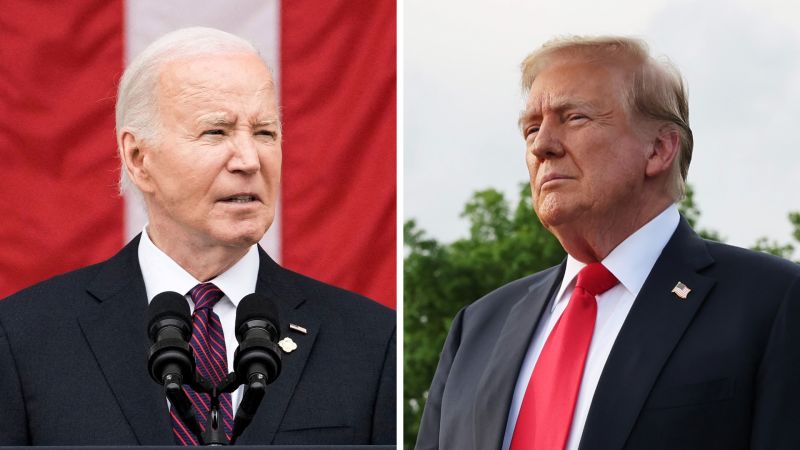CNN
—
For many years, Democrats have constructed their electoral methods on a typical assumption: the upper the turnout, the higher their possibilities of profitable. However that acquainted equation might not apply for President Joe Biden in 2024.
A big selection of polls this yr exhibits Biden working greatest amongst People with essentially the most constant historical past of voting, whereas former President Donald Trump usually shows essentially the most power amongst individuals who have been the least more likely to vote.
These new patterns are creating challenges for every celebration. Trump’s potential attraction to extra irregular voters, notably youthful Black and Latino males, is compelling Democrats to rethink longstanding methods that targeted on mobilizing as many youthful and non-White voters as doable with out worrying about their partisan allegiance. For Republicans, the problem will likely be to construct a company able to connecting with irregular voters they haven’t historically targeted on reaching, notably in minority communities.
“What all this implies is that this election has volatility,” says Daniel Hopkins, a College of Pennsylvania political scientist who has studied the widening partisan divergence between voters with and with no constant historical past of turning out. “We used to count on that the marginal non-voter, the subsequent voter who turned out if an election was very partaking, didn’t look completely different from individuals who did vote. On this case, the group that hasn’t gotten engaged appears to be like very, very completely different.”
Merged outcomes from the three most up-to-date nationwide NBC polls, performed by a bipartisan workforce of distinguished Democratic and Republican pollsters, as an illustration, discovered that Biden leads Trump by 4 proportion factors amongst individuals who voted in each 2020 and 2022. However amongst those that voted in 2020 however not 2022, Trump led Biden by 12 proportion factors. Trump’s lead swelled to twenty proportion factors amongst those that didn’t vote in both 2020 or 2022. Totally 65% of those that didn’t vote in both of the previous two elections mentioned they disapproved of Biden’s efficiency in workplace.
Mixed outcomes from latest nationwide New York Instances/Siena School polls likewise have discovered Biden narrowly main amongst potential 2024 voters who turned out in 2020 whereas trailing Trump by double digits amongst those that didn’t vote of their earlier contest.
Hopkins has performed maybe essentially the most formidable try and quantify the divergence between People with and with no historical past of voting. Earlier this yr, he and a colleague labored with NORC on the College of Chicago to survey over 2,400 adults about their preferences within the 2024 race. The ballot solely surveyed individuals who have been sufficiently old to vote in every of the previous three elections — the midterms of 2018 and 2022 and the 2020 presidential race.
The outcomes have been placing. Amongst adults who had voted in every of the previous three federal elections, Biden led Trump by 11 factors, and Biden eked out a slender benefit amongst voters who participated in two of the previous three races. However, the ballot discovered, Trump led Biden by 12 proportion factors amongst those that voted in simply one of many previous three elections and by a crushing margin of 18 proportion factors amongst those that got here out for none of them.
As vital, the sample held throughout racial traces. Within the ballot, Trump ran even with Biden amongst Latinos who voted in two, one or not one of the previous three elections, whereas Biden held an almost 20-point benefit amongst those that voted in all three. With Black voters, Biden’s lead was simply 10 factors amongst those that didn’t present up for any of the previous three elections, however over 80 factors amongst those that participated in all three.
Utilizing information from Catalist, a number one Democratic voter focusing on agency, Michael Podhorzer, the previous political director of the AFL-CIO, reached comparable conclusions. He discovered that in 2020 Biden’s margins over Trump have been larger amongst individuals who voted within the three earlier elections of 2018, 2016 and 2014 than those that voted in some or none of them — and that the connection held throughout racial traces.
Hopkins mentioned the hole between ordinary and irregular voters in his newest survey was far better than the distinction he discovered when he performed an identical ballot early within the 2016 race between Trump and Hillary Clinton. Key to this widening chasm, he believes, could also be one other dynamic: Adults who’re much less more likely to vote are additionally much less more likely to observe political information.
“For extra rare voters, these are sometimes individuals who pay much less consideration to politics and whose political barometer is extra the query of how is my household doing economically, how does the nation appear to be doing,” Hopkins mentioned. “For these voters, Donald Trump…just isn’t particularly uncommon.” Against this, Hopkins mentioned, a “sizable sliver” of ordinary voters “have a way that Trump could also be qualitatively completely different than different political candidates with respect to norm violations and January 6.” For much less frequent voters, he added, the equation could also be so simple as “they don’t love what they see with Joe Biden, and if Donald Trump is the individual working towards Joe Biden, they need change.”
The NBC polling outcomes buttress that conclusion: It discovered that among the many roughly one-sixth of voters who say they don’t observe political information, Trump led Biden by totally 2-to-1.
A number of analysts warning that whereas this divergence between high- and low-frequency voters is showing persistently in polls now, it’s too early to say for sure whether or not it’ll persist by Election Day.
“It’s Could,” mentioned Republican pollster Invoice McInturff, whose agency conducts the NBC ballot with a Democratic companion. “This information issues when individuals begin having to vote.” Democratic strategist Tom Bonier identified that public opinion surveys usually have sufficient hassle measuring attitudes amongst younger individuals and minorities, not to mention precisely capturing those that are most disengaged from the political system.
Melissa Morales — founder and president of Somos Votantes and Somos PAC, teams that mobilize Latino voters — mentioned that of their outreach campaigns this yr, they aren’t seeing the lean towards Trump amongst low-frequency voters evident in these a number of polls. Of their work throughout 2022, she mentioned, “We have been listening to it within the subject, with low propensity Latino voters, they have been open to Trump, particularly [over] the financial system.” However, she added, “We aren’t listening to that within the subject proper now” and as a substitute “what we’re listening to is deep concern about the price of residing, rising prices, and a robust want to know what the trail ahead is.”
Even with all these cautions, there are sturdy causes to imagine that Trump might profit extra from a really massive total turnout this yr than Biden would.
That conclusion is in step with the opposite uncommon demographic patterns evident within the 2024 election. Up to now, in virtually all polls, Biden is holding a better share of his 2020 vote amongst White than non-White voters; he’s additionally sustaining extra of his 2020 degree of help with seniors than with younger individuals. Amongst Whites, Biden, as in 2020, is working a lot better with those that maintain at the very least a four-year school diploma than those that don’t.
Biden’s relative power amongst seniors and college-educated White voters implies that he’s drawing from two of essentially the most dependable voting blocs within the voters. In 2020, about 75% of individuals older than 65 voted, in comparison with simply 54% of younger individuals aged 18-29, in line with calculations from Census information by William Frey, a demographer at Brookings Metro. (Even that was an enormous enhance in turnout amongst younger individuals from the 2012 and 2016 elections.) Way more White voters with levels turned out than these with out them as nicely.
Turnout was particularly modest among the many Black and Latino voters who’ve proven essentially the most receptivity to Trump — males with no school diploma. Solely barely lower than half of them voted in 2020, Frey discovered.
Most consultants who examine turnout think about it unlikely that as many individuals will vote this yr as in 2020, largely as a result of so many citizens maintain damaging views about each Biden and Trump. After a report 160 million individuals voted in 2020, Bonier mentioned his preliminary calculation is that turnout in 2024 is extra more likely to attain between 145-150 million with the likelihood that as few as 140 million individuals will vote. Jeremy Smith, CEO of Civitech, a Democratic voter information and focusing on agency, mentioned that the variety of individuals registered to even doubtlessly vote is manner down from the whole at this level within the 2020 cycle.
“Typically, in case you mentioned there are two doable electorates — one is 140 million individuals voting and one is 160 million individuals — the excessive chances are high that the 140 can be higher for Biden,” mentioned Bonier, a senior adviser and former CEO of TargetSmart, a number one Democratic focusing on agency.
If turnout shrinks from 2020, the important thing query for the 2 sides will likely be which voters fall away — and what number of new voters enter the voters to switch them.
Typically, Democrats imagine that within the Trump period the celebration advantages when essentially the most ordinary voters comprise a bigger share of the voters. Many Democrats imagine {that a} key cause the celebration exceeded expectations within the 2022 midterm is that the voters tilted greater than anticipated towards these common voters. The Democratic polling agency Equis Analysis, which focuses on Latino voters, as an illustration, present in its post-election evaluation that Democrats carried out barely higher than anticipated with that group largely as a result of irregular Latino voters, who have been extra receptive to Trump, failed to come back out.
Michael Madrid, a long-time GOP strategist who has develop into a fierce Trump critic, mentioned that the disappointing 2022 outcomes for Republicans confirmed the danger for the celebration within the turnout patterns that the previous president has triggered. Republicans below Trump, Madrid argued, are gaining help amongst non-White males, notably Latinos, whereas shedding help amongst college-educated White voters, particularly ladies. The hazard for the GOP, Madrid mentioned, is that the latter group seems at a far larger price than the previous (as Frey’s information exhibits).
Provided that disparity, Madrid argued, Trump “wants a excessive turnout” that pulls in much less dependable minority voters, particularly Latino males. Trump’s conundrum, Madrid mentioned, is that the belligerent rule-breaking persona that pulls these youthful non-White males alienates extra of the well-educated White ladies already trending away from him.
“He’s speaking to a single younger male between video video games: He’s obtained them, they love him,” Madrid mentioned. “However there are suburban ladies that you just lose by that, who hate that. That’s his dilemma. He will get the turnout, however he additionally will get the turnoff.”
The most effective-case state of affairs for Trump is that an unusually massive variety of these irregularly voting working-class minorities come out to vote for him. Given his success prior to now two elections at turning out irregularly voting working-class Whites, nobody reductions his possibilities of turning out irregularly voting working-class non-Whites this time. But it surely’s hardly assured: Although these voters are typically strongly discontented with the financial system, Democrats imagine they will loosen Trump’s maintain on them by highlighting his views on different points, resembling his pledges to implement a mass deportation effort towards undocumented migrants, or to pardon White supremacists convicted within the January 6, 2021, revolt. And as Podhorzer argued, unhappiness with the financial system traditionally has not confirmed to be a strong power in motivating irregular voters to point out up.
However Republicans level out that even when Trump doesn’t win as many of those irregularly voting non-White males as polls present at present, he’ll nonetheless profit in the event that they drift towards third-party candidates or just select to not vote. Wanting on the Black neighborhood, “even in case you don’t purchase the potential for Trump to flip a number of votes there, it appears there’s appreciable danger of a turnout drop-off that may hit Biden’s uncooked margins out of huge cities within the battlegrounds that Democrats often rely on,” mentioned GOP pollster Patrick Ruffini.
For that cause, many voter mobilization consultants say Democrats can’t surrender on rare voters exhibiting receptivity to Trump. Podhorzer identified that Democrats can nonetheless profit from excessive turnout if the marketing campaign’s closing weeks deal with the elements of Trump’s agenda that almost all alienate the irregular voters who surged to the polls towards him in 2020. Morales mentioned the variety of low-frequency Latino voters that Somos Votantes turned out in Nevada in 2022 exceeded Sen. Catherine Cortez Masto’s margin of victory there, and the group stays dedicated to reaching those self same voters for Biden.
“Not solely can we get them out to vote, however when we’ve got a dialog in regards to the distinction and what their votes imply on the problems, we will win these voters over,” Morales mentioned.
All of those dynamics might show most unstable with youthful voters. By way of the twenty first century, as first Millennials and now Era Z have entered the voters in massive numbers, Democrats have unwaveringly operated on the assumption that turning out as many younger voters as doable would profit the celebration.
However that’s a way more unsure proposition in 2024, as demonstrated by the most recent youth ballot from the Harvard Kennedy Faculty Institute of Politics, in all probability essentially the most in-depth take a look at attitudes amongst younger individuals. Within the IOP ballot this spring, Biden led Trump by practically 20 factors amongst younger adults (aged 18-29) who mentioned they undoubtedly plan to vote in November; that lead was similar to Biden’s benefit amongst all younger adults in 2020. However Trump’s place steadily improved because the chance of voting diminished, with the previous president main Biden by 2-to-1 amongst those that mentioned they in all probability wouldn’t vote.
Those that indicated they have been much less more likely to vote tended to be younger individuals with no school diploma, non-Whites and the very youngest cohort aged 18-24. John Della Volpe, the Institute of Politics’ polling director, identified that these youngest adults in all probability don’t bear in mind a lot about Trump’s presidency.
“Youthful voters at present have a special view of Trump,” mentioned Della Volpe, who suggested the Biden marketing campaign in 2020 on younger voters. “They have been 10, 12, 13 years previous when he descended down that escalator, when he blocked Muslims, when he pulled out of Paris [the international climate treaty], when he talked about Charlottesville. They have been youngsters. Their values don’t align together with his values, however there’s much less toxicity once you deliver up his title. So there’s this openness that wasn’t there within the final two elections.”
Whilst just lately as 2020, Della Volpe mentioned, Democrats may goal younger individuals with what politicians within the previous big-city machines used to name a “blind pull” — the place a celebration can deal with turning out everybody in a specific neighborhood as a result of such a excessive proportion of them will reliably vote for them. This yr, he mentioned, with younger voters, “it’s undoubtedly extra sophisticated. It’s not a blind pull.”
Della Volpe’s remark underscores how Trump’s power amongst irregular voters may power Democrats to rethink their techniques. A lot of the voter registration and turnout work aimed toward minority and younger voters has traditionally operated by liberal non-profit organizations that focus on the broad inhabitants in these teams on the belief that almost all of them will finally favor Democrats.
However this yr, some Democratic strategists fear that casting such a large internet may inadvertently mobilize an unusually massive variety of peripheral voters who favor Trump. That would compel Democrats to modify extra of their registration and turnout efforts towards explicitly partisan applications, which may goal voters extra exactly based mostly on their partisanship, however that are harder to lift cash for. “You’re listening to extra teams struggling as a result of their thesis has been ‘I take [non-profit] {dollars} to get, say, all non-White voters’” to register and turnout, mentioned Smith of Civitech.
For Republicans, the mirror picture crucial is discovering methods to prepare the irregular Black and Latino voters exhibiting openness to Trump. Republicans don’t have a lot historical past of courting these voters, and, sarcastically, any effort to take action could also be impeded by the limitations to voting that many Republican-controlled states have erected since 2020. Republicans additionally face the complication that Trump’s diversion of huge quantities of his fundraising towards his authorized protection might imply there’s much less cash accessible to put money into on-the-ground marketing campaign operations.
That will not matter a lot if the mixture of Trump’s ubiquitous media presence and discontent with Biden’s report encourages sufficient irregular voters open to the previous president to end up in November. Primarily based on the leads to 2018, 2020 and 2022, Democrats can really feel assured that at the very least as many ordinary voters are hostile to Trump as dedicated to him, notably in many of the battleground states that may determine the election. The decisive variable for 2024 could also be how many individuals past that inside core of essentially the most dependable voters present up and whether or not they break for the previous president as decisively as most polls now recommend.











